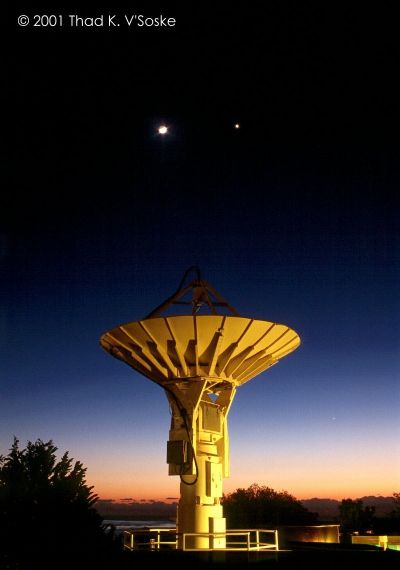Credit & Copyright: Thad K. V'Soske
Explanation:
Have you seen a bright evening star
in the western sky lately?
That's no star, that's planet Venus the second "rock"
from the Sun.
Blazing at -4.6
magnitude, Venus, after the Sun and Moon,
is the third brightest celestial body in
planet Earth's sky.
Venus is closer to the Sun than Earth and
as Venus orbits
the Sun it is seen to go through
phases similar to the Moon.
But unlike the Moon, as
Venus waxes and wanes
its distance from Earth and hence its apparent size changes drastically.
This causes
Venus to look brighter
as it looms large in its
crescent phases than when it is smaller and nearly full.
Taken on January 28th, this dramatic picture finds a crescent
Venus near its brightest to the right of a crescent Moon.
The brilliant rivals seem poised above a satellite dish of the
Scripps Satellite Oceanography Facility.
Closer to the horizon,
just below and to the right of the satellite dish,
Mercury pierces the twilight glow.
1999 2000 2001 2002 2003 2004 2005 2006 2007 2008 2009 2010 2011 2012 2013 2014 2015 2016 2017 2018 2019 2020 2021 2022 2023 2024 2025 |
Yanvar' Fevral' Mart Aprel' Mai Iyun' Iyul' Avgust Sentyabr' Oktyabr' Noyabr' Dekabr' |
NASA Web Site Statements, Warnings, and Disclaimers
NASA Official: Jay Norris. Specific rights apply.
A service of: LHEA at NASA / GSFC
& Michigan Tech. U.
|
Publikacii s klyuchevymi slovami:
Moon - Venus - Mercury - evening sky - Venera - Luna - Merkurii - vechernee nebo
Publikacii so slovami: Moon - Venus - Mercury - evening sky - Venera - Luna - Merkurii - vechernee nebo | |
Sm. takzhe:
Vse publikacii na tu zhe temu >> | |
